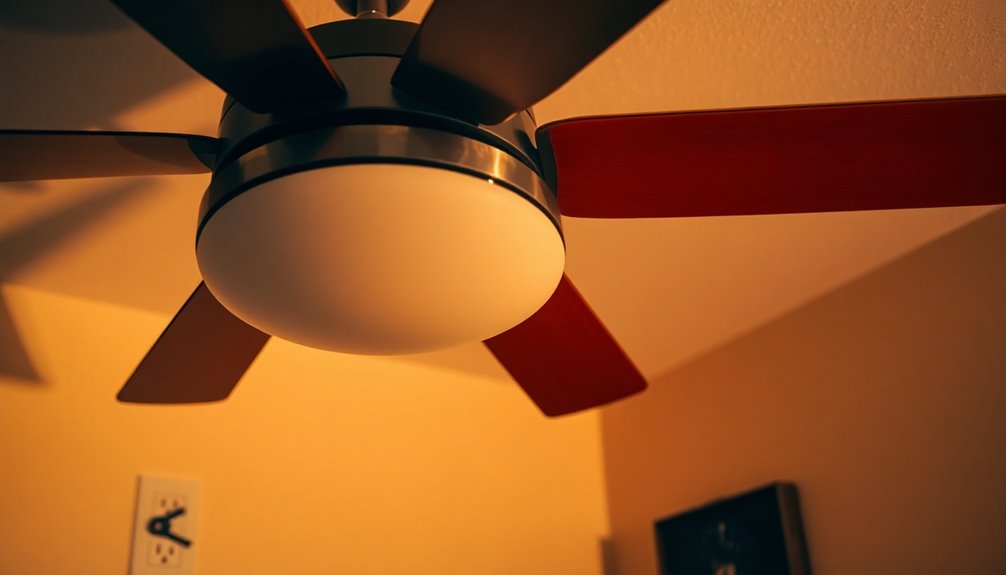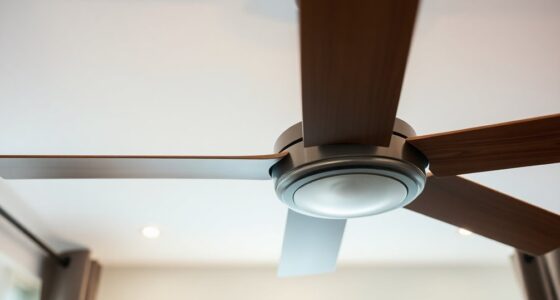If your fan's spinning but not blowing air, check a few common issues first. Make sure the fan blades are rotating counterclockwise for cooling. Misaligned blades or improper sizing can also impact airflow. Don't forget to inspect the fan's base for tilting; that can block air movement too. Electrical problems, like faulty capacitors or loose wiring, might slow it down. Lastly, dust buildup can hinder performance, so a regular clean can help. There are more tricks to troubleshoot and get your fan working effectively, ensuring you stay cool where it counts.
Key Takeaways
- Check if the fan blades are misaligned or obstructed, as this can hinder airflow despite spinning.
- Inspect for electrical issues like faulty capacitors or loose wiring that could affect performance.
- Ensure the fan is placed on a level surface; a tilted base can disrupt proper airflow.
- Clean the fan to remove dust buildup, which can restrict airflow even when the fan is operational.
- Verify that the fan size and type are appropriate for the room to ensure efficient air circulation.
Incorrect Fan Rotation Direction
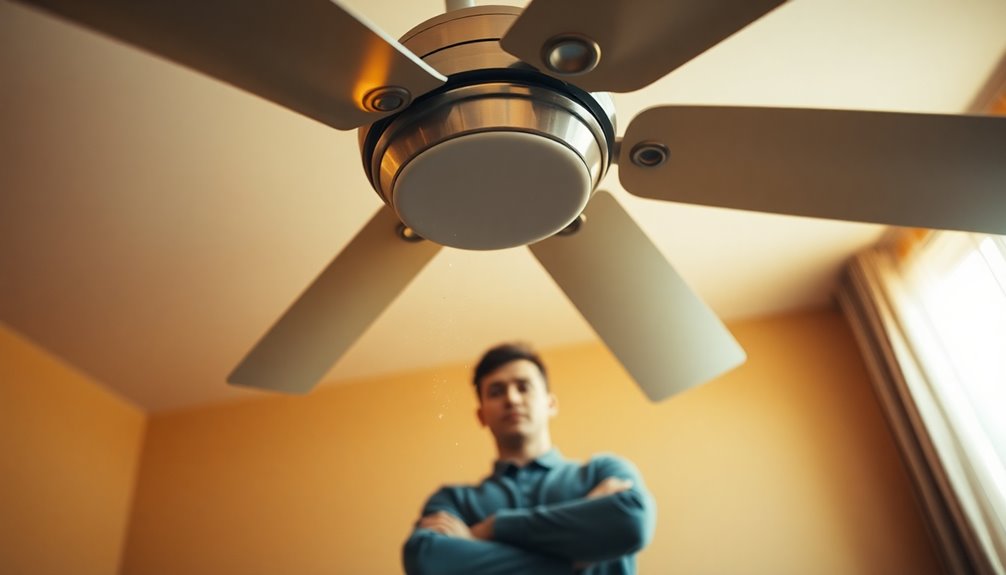
If you've noticed that your fan is spinning but not blowing air effectively, one possible culprit could be the incorrect rotation direction. Many fans have a direction switch that may be set incorrectly. For summer, ensure it's rotating counterclockwise to create that refreshing wind chill effect.
Misaligned blades can also hinder airflow, so check that they're properly secured and aligned. A defective or miswired capacitor might cause the fan to rotate the wrong way, and electrical issues like blown fuses or loose wiring can contribute, too. Additionally, using blades of the ideal size is crucial for maximizing airflow efficiency.
Finally, if the fan's installation is off, like a tilted base, it mightn't function as intended. Address these issues to restore your fan's cooling performance.
Improper Blade Size

When your fan isn't blowing air effectively, improper blade size might be the issue at hand. Blade length significantly impacts airflow; increasing it by just 10% can boost airflow by 33%. However, this also raises power consumption by 50%, possibly requiring a more robust motor. The blade area also matters—larger areas can enhance airflow but can compromise aesthetics and efficiency. While the number of blades contributes to airflow, it's not the only factor; more blades can create drag, slowing the fan down. Proper installation and clearance also affect airflow efficiency, which is essential for optimal performance. Ideally, your fan's design should balance blade size, area, and count to maximize airflow while managing power use. If you suspect improper blade size, consider these factors for optimal performance.
Tilted Fan Base
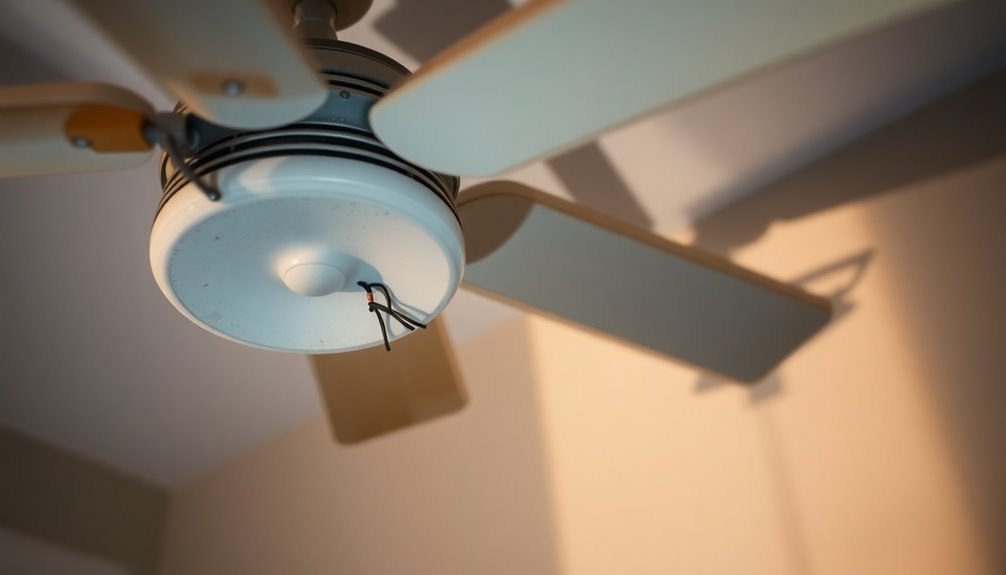
Improper blade size can impact your fan's performance, but a tilted fan base can also lead to ineffective airflow.
If your fan's base isn't level, it could be due to an uneven surface, incorrect installation, or loose screws. When the base tilts, you might notice the blades aren't rotating properly, resulting in reduced airflow and excessive noise or vibration. Airflow obstruction from surrounding objects can also contribute to this issue.
To check for a tilted base, turn off the power and inspect the hanger bracket screws. Tighten any loose screws and ensure the fan is level.
If it's still tilted after your adjustments, you may need to realign the blades or consult a professional to resolve any structural issues affecting your fan's stability.
Inappropriate Fan Style

Choosing the right fan style is crucial for ensuring optimal airflow in your space. If you've got a fan with blades that are too small, you'll likely notice insufficient airflow. Conversely, oversized blades can create too much wind resistance.
Make sure your fan size matches your room dimensions and ceiling height; a mismatch can lead to poor performance. Additionally, using the wrong fan type can hinder circulation. For instance, dust collector fans aren't designed for air movement, and pedestal fans aren't meant for ceiling installation.
Lastly, check for design issues like misaligned blades or poor motor efficiency, as these can also impact airflow. Addressing these factors can help your fan blow air effectively. Regular maintenance can prevent mechanical failures that may affect airflow and overall performance.
Slow Fan Speed Issues
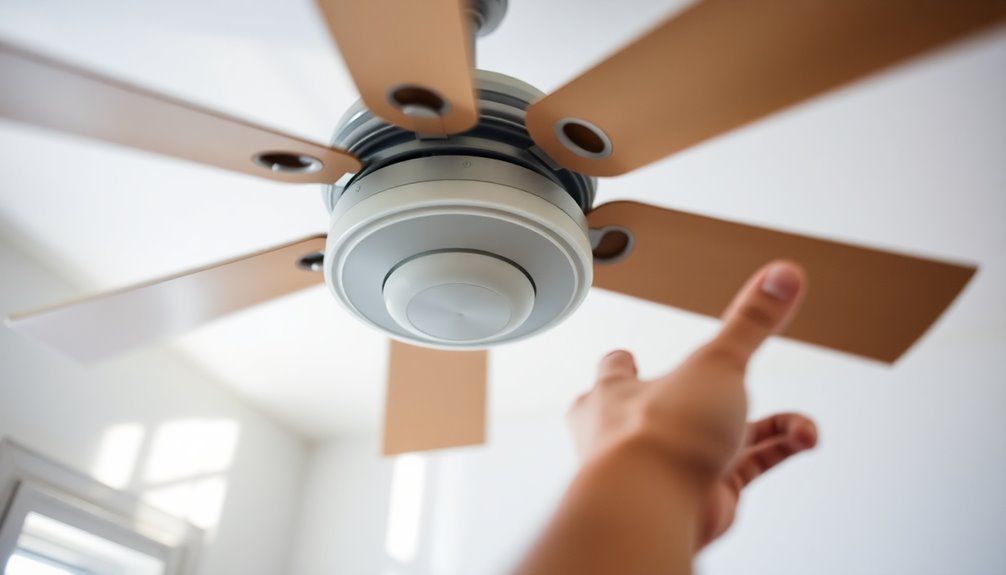
Have you ever noticed your fan spinning slowly, leaving you wondering why it's not moving much air? Several factors could be at play.
First, check for electrical issues like a faulty capacitor or loose wiring; these can significantly affect speed. If the power supply is insufficient, the fan may struggle to perform.
Next, consider mechanical components. Misaligned blades or lack of lubrication can slow it down. Dust buildup is another culprit that can hinder airflow. Regularly cleaning and lubricating fan components can help improve overall efficiency.
External factors like poor ventilation or incorrect installation can also impact performance.
Lastly, age-related wear on the motor and bearings can lead to slower speeds. Addressing these issues can help restore your fan's efficiency.
Frequently Asked Questions
Can a Ceiling Fan Cause Noise Without Airflow?
Yes, a ceiling fan can definitely make noise without producing airflow.
You might hear rattling, buzzing, or grinding sounds due to loose parts, imbalanced blades, or motor issues.
For instance, loose screws or misaligned blades can create vibrations that lead to noise, even if the fan isn't moving air effectively.
Regular maintenance and inspection can help minimize these sounds, ensuring your fan operates quietly and efficiently.
How Do I Clean My Ceiling Fan Blades?
Cleaning your ceiling fan blades is like giving your favorite book a good dusting; it keeps things fresh and enjoyable. Not only does it enhance the overall ambiance of your space, but a clean ceiling fan also complements your home decor, especially if you’re incorporating various boho lifestyle elements. These elements, characterized by their eclectic mix of textures and colors, require a backdrop of cleanliness to truly shine. By maintaining the fan, you’re not just improving air circulation; you’re also ensuring that your bohemian sanctuary remains as inviting and vibrant as ever.
Start by protecting your space with a drop cloth and turning off the power.
Use a long-handled duster to remove dust, or try the pillowcase method.
Wipe each blade with a damp cloth, ensuring they dry thoroughly before turning the fan back on.
Regular maintenance keeps your fan efficient and your air clean!
Is It Safe to Operate a Fan With Damaged Blades?
Operating a fan with damaged blades isn't safe.
You'll likely hear unusual noises, and the fan mightn't cool effectively. Continued use can lead to increased wear on components, higher energy bills, and potential safety hazards, like blades breaking off and causing injury.
It's best to inspect the blades regularly and address any damage promptly. If the damage is severe, consider replacing the fan to avoid costly repairs and ensure your safety.
How Often Should I Check My Fan for Issues?
You should check your fan regularly to ensure it's working efficiently.
Inspect it daily for dust, weekly for blade alignment, and monthly to verify the rotation direction.
Quarterly, look for tilting in the base, and annually, consider replacing worn-out parts.
Don't forget to make seasonal adjustments for optimal performance, and keep an eye on electrical connections.
Regular maintenance will help you catch issues early and extend your fan's lifespan.
Can I Use a Fan Outdoors Safely?
Yes, you can use a fan outdoors safely, but you need to choose the right type.
Look for a fan with a UL damp or wet rating to ensure it can handle moisture.
Installation by a professional is crucial, so hire an electrician to secure it properly.
Regular maintenance, like cleaning the blades and checking for rust, will help keep it functioning well and safe for outdoor use.
Conclusion
In conclusion, if your fan's futilely spinning yet failing to furnish fresh airflow, don't despair! Diligently delve into the details of direction, design, and dynamics. By addressing issues like incorrect rotation, improper sizing, and slow speeds, you can potentially pinpoint the problem. With a little troubleshooting tenacity, you'll transform your fan from a mere spectacle to a steady source of soothing, circulating air. So, take action and restore that refreshing breeze!
